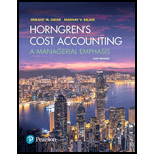
Concept explainers
Direct, indirect, fixed, and variable costs. California Tires manufactures two types of tires that it sells as wholesale products to various specialty retail auto supply stores. Each tire requires a three-step process. The first step is mixing. The mixing department combines some of the necessary direct materials to create the material mix that will become part of the tire. The second step includes the forming of each tire where the materials are layered to form the tire. This is an entirely automated process. The final step is finishing, which is an entirely manual process. The finishing department includes curing and quality control.
- 1. Costs involved in the process are listed next. For each cost, indicate whether it is a direct variable, direct fixed, indirect variable, or indirect fixed cost, assuming “units of production of each kind of tire” is the cost object.
| Costs: | |
| Rubber | Mixing department manager |
| Reinforcement cables | Material handlers in each department |
| Other direct materials | Custodian in factory |
| Night guard in factory | |
| Depreciation on mixing machines | Machinist (running the mixing machine) |
| Rent on factory building | Machine maintenance personnel in each department |
| Fire insurance on factory building | Maintenance supplies for factory |
| Factory utilities | Cleaning supplies for factory |
| Finishing department hourly laborers | Machinist (running the forming machines) |
- 2. If the cost object were the “mixing department” rather than units of production of each kind of tire, which preceding costs would now be direct instead of indirect costs?
Learn your wayIncludes step-by-step video

Chapter 2 Solutions
REVEL for Horngren's Cost Accounting: A Managerial Emphasis -- Access Card (16th Edition) (What's New in Accounting)
Additional Business Textbook Solutions
Foundations Of Finance
Operations Management
Corporate Finance (4th Edition) (Pearson Series in Finance) - Standalone book
Horngren's Cost Accounting: A Managerial Emphasis (16th Edition)
Intermediate Accounting (2nd Edition)
Financial Accounting (12th Edition) (What's New in Accounting)
- Department A had 15,000 units in work in process that were 60% completed as to labor and overhead at the beginning of the period; 45,600 units of direct materials were added during the period; 42,500 units were completed during the period, and 11,000 units were 80% completed as to labor and overhead at the end of the period. All materials are added at the beginning of the process. The first-in, first-out method is used to cost inventories. The number of equivalent units of production for conversion costs for the period was ____ Units. Need Solutionarrow_forward??arrow_forwardProvide answerarrow_forward
 Cornerstones of Cost Management (Cornerstones Ser...AccountingISBN:9781305970663Author:Don R. Hansen, Maryanne M. MowenPublisher:Cengage Learning
Cornerstones of Cost Management (Cornerstones Ser...AccountingISBN:9781305970663Author:Don R. Hansen, Maryanne M. MowenPublisher:Cengage Learning Managerial Accounting: The Cornerstone of Busines...AccountingISBN:9781337115773Author:Maryanne M. Mowen, Don R. Hansen, Dan L. HeitgerPublisher:Cengage Learning
Managerial Accounting: The Cornerstone of Busines...AccountingISBN:9781337115773Author:Maryanne M. Mowen, Don R. Hansen, Dan L. HeitgerPublisher:Cengage Learning

